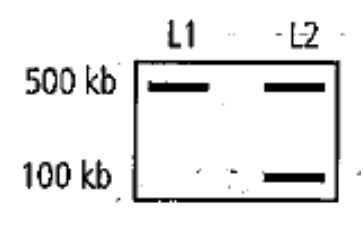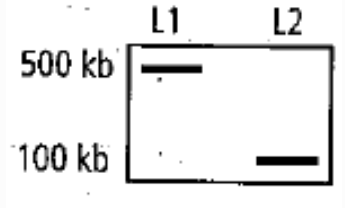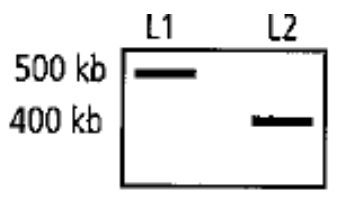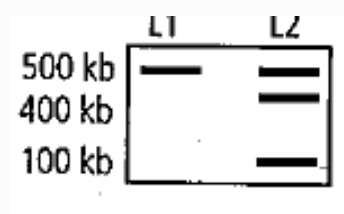The figure shows the restriction enzyme cutting sites (R1−R3) in wild type (n) and mutant (n) gene.

If a radioactively labelled probe (that hybridises at a sequence close to R1) is used for detecting the presence of DNA fragments after gel electrophoresis and Southern blotting, which of the following band patterns will yout expect ?
Note : L1 : wild type DNA, L2: mutant DNA




The correct Answer is:C
Restriction enzymes recongise the base sequence of palindrome sites in DNA duplex and cut is strands. After the cutting of DNA by restriction enzymes, fragments of DNA are formed. Separation of DNA fragments according to their size is done by gel electrophoresis. since the probe hybridises close to R1 it will give 500 kb band for L1 and 400 kb band for L2 after gel electrophoresis.
Topper's Solved these Questions
Similar Questions
_____ are the enzymes used for cutting the DNA molecule into fragments. An example for this type of enzyme is Eco RI. What does Eco, R and 1 stand for ?
View SolutionThe Given question are based on the alphabetical series given below :
C L R T B Q S M A P D I N F J K G Y X
If CT is related to RQ and AI is related to DF in a certain way, to which of the following is SP related to, Given the same pattern?
1) MD
2) DN
3) AD
4) AI
5) DF
View Solution
Knowledge Check
Identify the true statements:
A. The first recombinant DNA was constructed by using a piece of DNA from a plasmid carrying antibiotic resistance gene in the bacterium Salmonella typhimuriu and linked it to the plasmid to E. coil.
B. Cohen and Boyer are known as father of genetic enginnering.
C. When cut by the same restriction enzyme, the resultant DNA fragments have the same kind of sticky ends and these can be joined together using DNA ligases.
D. Endonucleases remove nucleotides from the ends of the DNA whereas exonuclease make cuts at specific positions within the DNA.
E. Presence of more than one recoginition sites with the vector will generate several fragments, which will complicate the gene cloning
F. Humulin was the first recombinant DNA based product, produced and marketed in India.
G.YAC vectors contain the telomeric sequence, the centromene and autonomously replicating sequence from yeast chromosomes.
H. Alkaline phosphatase, is used to prevent unwanted salf ligation of the vector DNA molecules in procedures of r DNA technology.
I. pBR322 vector was the first artificial ideal vector constructed by Boliver and Rodriguer.
J. Plasmid DNA is coated wiht histone proteins and can act as genetic factor.AB,D,F,JBB,D,E,JCA,C,E,G,H,IDA,B,D,F,JIn the given figure, l,m and n are three parallel lines and t1 and t2 are two transversal lines which cut l,m and n at A, B, C and P, Q, R, respectively. Which of the following options is correct?
 ABCPQ=ABQRBAPBQ=BQCRCABBC=PQQRDBQAP=PQAB
ABCPQ=ABQRBAPBQ=BQCRCABBC=PQQRDBQAP=PQAB_E01_090_Q01.png)
Thin films, including soap bubbles and oil slicks, show patterns of alternating dark and bright regions resulting from interference among the reflected light waves. If two waves are in phase their crest and troughs will coincide. The interference will be constructive and the aplitude of the resultant wave will be greater than the amplitude of either constituent wave. if the two waves are out of phase, the crests of one wave will coincide with the troughs of the other wave. The interference will be destructive and the amplitude of the resultant wave will be less than that of either constituent wave. at the interface between two transparent media some light is reflected and some light is refracted.
* When incident light, reaches the surface at point a, some of the light is reflected as ray Ra and and some is refracted following the path ab to the back of the film.
*At point b some of the light is refracted out of the film and part is reflected back refracted out of the fiml as ray Rc. Ra and Rc are parallel. However, Rc has travelled the extra distance within the film of abc. if the angle of incidence is small then abc is approximately twice the film's thickness. if Ra and Rc are in phase they will undergo constructive interference and the region ac will be bright if Ra and Rc are out of phase, they will undergo destructive interference.
* Refraction at an interface never changes the phase of the wave.
* For reflection at the interface between two media 1 and 2, if n1<n2 the reflected wave will change phase by π.
if n1>n2 the reflected wave will not undergo a phase change. for reference nair=1.00
* if the waves are in phase after refection at all interfaces, then the effects of path length in the film are
Constructive interference occur when (n= refractive index) 2t=mλ/n m=0,1,2,3.....
Destructive interference occurs when 2t=(m+1/2)λ/n m=0,1,2,3...
Q. A 600 nm light is perpendicularly incident on a soap film suspended in air. The film is 1.00 μm thick with n=1.35. Which statement most accurately describes the interference of the light reflected by the two surfaces of the film?AThe waves are close to destructive interferenceBThe waves are close to constructive interferenceCThe waves show complete desctructive interferenceDThe waves show complete constructive interference.
In this sectin each item consists of six sentences of a passage. The first and sixth sentences are given in the beginning as S1 and S6. The middle four sentences in each have been jumbled up and labelled as P, Q, R and S. You are required to find the proper sequence of the four sentences and mark your response accordingly on the Answer Sheet.
S1 : Palaeontology is the study of the remains of dead organisms over enormous spans of time.
S6 : Faunal analysis gives information about the animal people hunted and domesticated, the age of animal at death, and the diseases that afflicted them.
P : Bones provide a great information.
Q : The distribution of faunal remains (animal bones) at a site can indicate which areas were used for butchering, cooking, eating, bone tool making and refuse dumping.
R : Within this discipline, molecular biology and DNA studies have been used to understant hominid evolution.
S : Hominid evolution answers the questions about what ancient people looked like, and to plot patterns of migration.
The correct sequence should be
View SolutionConductors allow the passage of electric current through them. Metallic and electrolytic are the two type of conductors. Current carriers in metallic and electrolytic conductors are free electrons and free ions respectively. Specific conductance or consuctivity of the electrolyte solution is given by the following relation :
κ=c×lA
where, c=1/R is the conductance and l/A is the cell constant. Molar conductance (Λm) and equivalence conductance (Λe) of an electrolyte solution are calculated using the following similar relations :
Λm=κ×1000M
Λe=κ×1000N
Where, M and N are the molarity and normality of the solution respectively. Molar conductance of strong electrolyte depends on concentration :
Λm=Λ∘m−b√c
where, Λ∘m= molar conductance at infinite dilution
c= concentration of the solution
b= constant
The degrees of dissociation of weak electrolytes are calculated as :
α=ΛmΛ∘m=ΛeΛ∘e
Which of the following equality holds good for the strong electrolytes ?
View SolutionConductors allow the passage of electric current through them. Metallic and electrolytic are the two type of conductors. Current carriers in metallic and electrolytic conductors are free electrons and free ions respectively. Specific conductance or consuctivity of the electrolyte solution is given by the following relation :
κ=c×lA
where, c=1/R is the conductance and l/A is the cell constant. Molar conductance (Λm) and equivalence conductance (Λe) of an electrolyte solution are calculated using the following similar relations :
Λm=κ×1000M
Λe=κ×1000N
Where, M and N are the molarity and normality of the solution respectively. Molar conductance of strong electrolyte depends on concentration :
Λm=Λ∘m−b√c
where, Λ∘m= molar conductance at infinite dilution
c= concentration of the solution
b= constant
The degrees of dissociation of weak electrolytes are calculated as :
α=ΛmΛ∘m=ΛeΛ∘e
Which of the following decreases on dilution of electrolyte solution ?
View SolutionConductors allow the passage of electric current through them. Metallic and electrolytic are the two type of conductors. Current carriers in metallic and electrolytic conductors are free electrons and free ions respectively. Specific conductance or consuctivity of the electrolyte solution is given by the following relation :
κ=c×lA
where, c=1/R is the conductance and l/A is the cell constant. Molar conductance (Λm) and equivalence conductance (Λe) of an electrolyte solution are calculated using the following similar relations :
Λm=κ×1000M
Λe=κ×1000N
Where, M and N are the molarity and normality of the solution respectively. Molar conductance of strong electrolyte depends on concentration :
Λm=Λ∘m−b√c
where, Λ∘m= molar conductance at infinite dilution
c= concentration of the solution
b= constant
The degrees of dissociation of weak electrolytes are calculated as :
α=ΛmΛ∘m=ΛeΛ∘e
For which of the following electrolytic solution Λm and Λe are equal ?
View SolutionThis section contains Assertion (a) and Reasons (R) type questins. Each questin has 4 choices (1), (2), (3) and (4), out of which only one is correct.
(1) Bothe Assertion and Reason are correct and Reason is the correct explanation of the Assertion
(2) Both Assertion and Reason are correct but Reason is not the correct explanation of Assertion
(3) Assertion is correct but Reason is incorrect
(4) Both Assertion and Reason are incorrect
Assertion(A) For n=3, l may be 0, 1 and 2 and m may be0,0,±1,0,±1and±2.
Reason(R) for each value of n, there are 0 to (n-1) possible value.
View Solution
